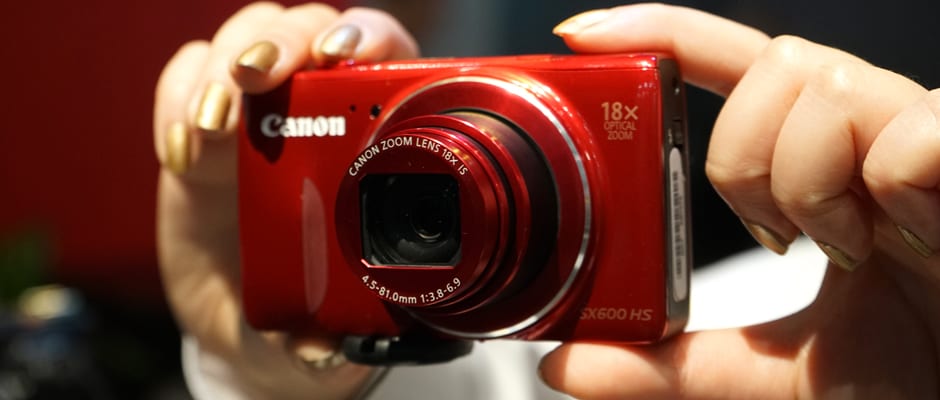Pros
Cons
Our First Take
Among the new announcements is a refreshed travel zoom: the PowerShot SX600 HS. Boasting more megapixels, NFC pairing, and a slightly shorter zoom than the SX280 HS, the newest long-zoom PowerShot makes few sacrifices under the hood to attain its more accessible price point. Debuting at $249.99, the SX600 may not be awe-inspiring, but it's a good fit for those looking for a simple all-in-one.
Though it's a little underwhelming in the spec department, what the SX600 offers over its older brother is a simple control scheme and more streamlined WiFi features. However, considering that the SX280 is still close in cost (and arguably offers more under the hood), interested parties might want to wait for the inevitable price-drop.
Design & Usability
Business up front...
Fans of pocketable point-and-shoots will appreciate the SX600's somewhat slim profile and reasonably light weight. At only 6.6 ounces with the included NB-6L rechargeable battery, the SX600 HS is very easy to whip out and start shooting with. Because it's slim, you can easily stow it in a bag or jacket pocket without it bursting at the seams.
You could be forgiven for mistaking the silhouette of the SX600 for the older SX280, but the similarities in design diverge from there. The newer addition to the PowerShot line has uniform coloring on the front, and a 461k-dot, 3-inch LCD on the back. Ditching the SX280's mode knob, the SX600 has a very basic collection of controls—including a d-pad control cluster, menu button, mode switch, playback button, and video recording button.
An 18x zoom lens (25–450mm equivalent with a f/3.8–6.9 aperture range) is anchored in front of a 16-megapixel, 1/2.3" CMOS sensor. Like the telescoping lens found on the SX280, the one in the SX600 rests flush against the outside casing when the camera is turned off. Though the zoom ratio is slightly smaller this time around, that has its plusses. Specifically, it's a tad easier to get a shot at full telephoto without it becoming a blurry mess.
{{photo_gallery "design"}}
Features
...WiFi party in the back
A spec sheet would paint you a picture of a camera with many similar features to the older SX280 HS, but that's not the whole story. Though it does have WiFi pairing, there's a new twist to the social media snap-sharing medium: NFC. After hitting the button stamped with a smartphone icon, you can tap your NFC-enabled mobile to the camera, and the pairing process happens automatically. Much easier than trying to type in an SSID and password with a D-pad, right?
Circling back to that DIGIC 4+ processor, we feel it necessary to point out that the chip isn't a bad one for a point and shoot—just not as beefy as the DIGIC 6 found in other Canon PowerShots. It still allows you to capture 1080p/30p HD video (in MP4 format), enables an ISO range of 100-3200, and supports a shot-to-shot speed of about 10 frames per second. That's certainly not bad at all, but not groundbreaking either.
However, the mundane processor pays real dividends in battery life. Given the camera's generally conservative specs, the slower chip has few tradeoffs in straight-up performance but allows for 290 (CIPA standard) shots before the proprietary lithium-ion cell needs a recharge. That's a useful tradeoff if I ever saw one, and great for those who aggressively fill their memory cards.
Conclusion
Few clear advantages, but options are good.
Filling an in-between role, the SX600 is flanked in the PowerShot lineup by the SX170 HS and SX280 HS. In short, it's a smartly priced if somewhat anonymous point-and-shoot. For the most part, we're okay with that. Having options is a good thing, and the PowerShot line gives you more options than any other camera family on the market today.
Catering as it does to beginners, this is a very easy camera to use. In our opinion, that's a good thing: There's nothing wrong with a simplified control scheme so long as it doesn't omit the key controls, and the SX600 HS does a great job of providing a familiar set of buttons with minimal menu complication. It does this with only a few sacrifices, showing the degree to which Canon has refined its point-and-shoot offerings over the years.
Those looking for more features and performance will probably elect to take the step up to the SX280 HS, but probably won't end up paying much more at this point in its life cycle. However, sharing photos over WiFi is much easier with the SX600 HS, making it a better fit for those looking to get their snaps out on social media quickly.
Though we can't comment on image quality just yet—we haven't put it through its paces in our labs, after all—we're anxious to see what it can do. We'll be sure to report back once we get a production sample in and subject it to our gantlet of tests.
Meet the tester
A seasoned writer and professional photographer, Chris reviews cameras, headphones, smartphones, laptops, and lenses. Educated in Political Science and Linguistics, Chris can often be found building a robot army, snowboarding, or getting ink.
Checking our work.
Our team is here to help you buy the best stuff and love what you own. Our writers, editors, and experts obsess over the products we cover to make sure you're confident and satisfied. Have a different opinion about something we recommend? Email us and we'll compare notes.
Shoot us an email

